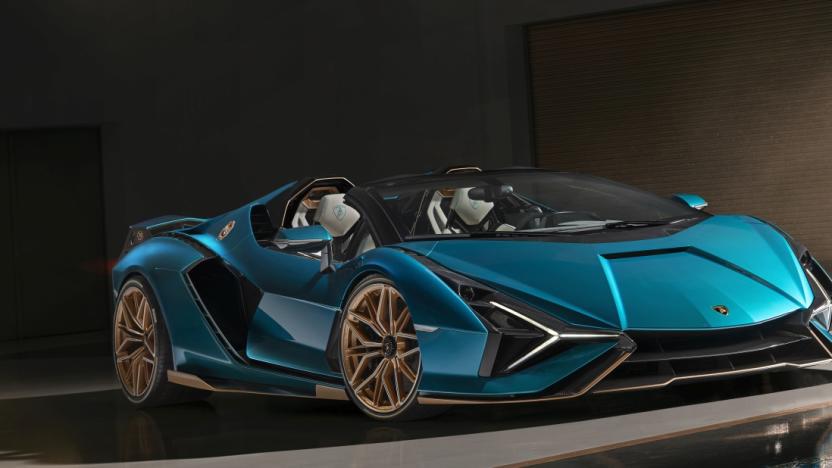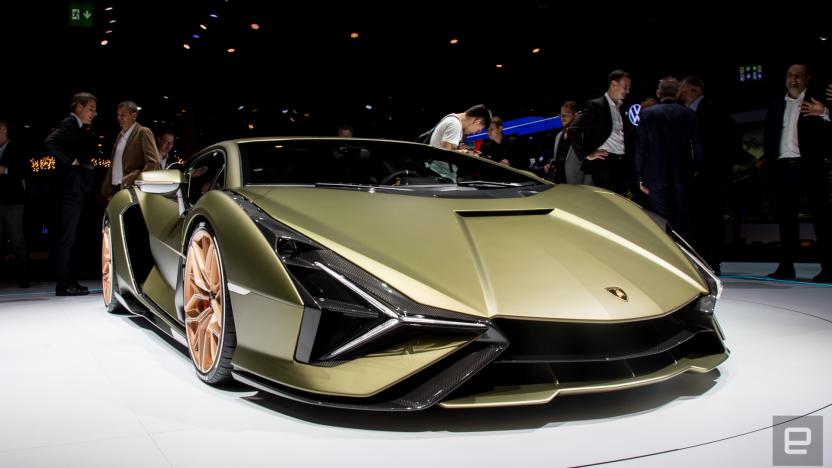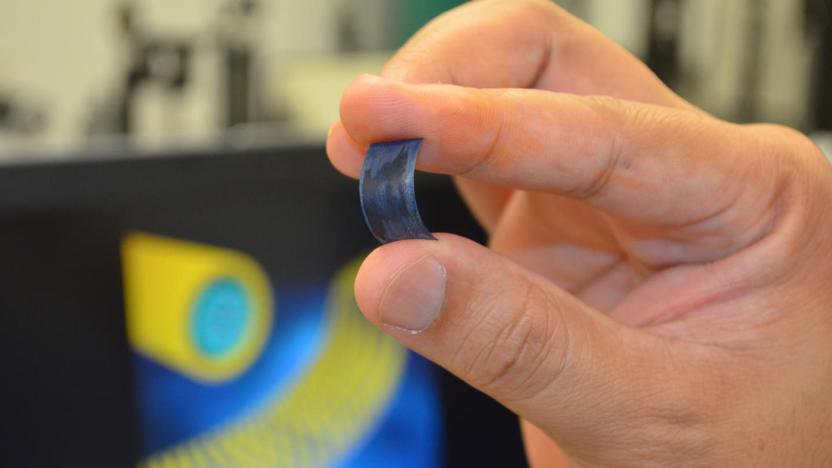supercapacitor
Latest

Lamborghini Sian Roadster drops the top, adds custom 3D printed vents
Last year Lamborghini debuted the 819HP Sian hybrid, its supercar with a supercapacitor, and now it’s back after deleting one pesky detail. This Sian Roadster is no convertible — there is no roof at all, so owners can always hear the V12 engine it pairs with a 48-volt electric motor more clearly. As Lamborghini CTO Maurizio Reggiani explained to Engadget last fall, the supercapacitor stores and discharges energy much more quickly than the lithium ion batteries most hybrids use.

Lamborghini’s crazy looking hybrid is more interesting under the hood
"We are a game-changer and a provocateur," Lamborghini's CTO, Maurizio Reggiani told Engadget. The automaker has a long history of making waves with traffic-stopping designs and more recently, innovative tech. At last week's Frankfurt Motor Show, the Italian company unveiled its Sian hybrid supercar. But it ditched the traditional battery pack in favor of a supercapacitor to power an electric motor, which is exactly what you would expect from the Italian company.

Lamborghini's V12 gets electrified with the 819HP Sian hybrid
The first electrified Lamborghini doesn't disappoint. If anything, the green-tinted Sian with its fins, channels and hyper-sharp styling feels like the most Lamborghini thing the company builds.

Lamborghini's first hybrid supercar is the 819HP Sián
Even Lamborghini can't resist the pressure to electrify its lineup, although it's definitely not following a conventional route. The Italian automaker has introduced the Sián ("flash" or "lightning" in Bolognese dialect), its first hybrid car, and the emphasis here is on raw performance over eco-friendliness. The coupe mates a 785HP V12 engine with a 34HP electric motor that provides both "immediate response" and, conveniently, the most power ever in a production Lamborghini. It can reach 62MPH in a brisk 2.8 seconds while reaching a 217MPH top speed, and you'll see tangible improvements in traction force that help it out-accelerate previous beasts like the Aventador SVJ.

Energy storage breakthrough could boost EV range and slash charge time
Electric cars could soon have as much range as petrol and diesel cars -- and recharge in a matter of minutes -- thanks to what researchers are calling a "breakthrough" in energy storage technology. Teams from Bristol University and Surrey University have created a new material for supercapacitors, which store electric charge, that could see EVs recharge in as little as 10 minutes compared to the eight hours it can take for EVs with lithium-ion batteries. And according to the researchers, it boasts enough energy density to see EVs surpass even the top range of current leading models, such as Teslas. Elon Musk himself has previously said a breakthrough in EV technology would likely come from supercapacitors, rather than batteries.

An electric cargo ship is delivering coal in China
An all-electric cargo ship is now in use in China and it boasts an impressive 2.4 MWh energy storage capacity, Electrek reports. The ship is over 230 feet long, 45 feet wide and 14 feet deep and can carry a maximum of 2,000 tons. Supercapacitors and lithium batteries make up the energy storage system and the ship can go about 50 miles on one charge. It will run between two shipyards, each of which has a charging station that can recharge the ship in around two hours.

Researchers create more efficient supercapacitor to power wearables
Supercapacitors offer a lot of advantages over batteries when it comes to energy storage. They can store a lot more of it, they can take on or transmit energy much more quickly and they typically last way longer. But incorporating supercapacitors into things like wearables has been difficult because making them flexible and stretchable comes with some costs. Usually, flexible supercapacitors are made with complex and pricey methods or are limited to just a few types of materials. They can also end up being less stable and, thus, short-lived. And a major problem with these sorts of supercapacitors is actually getting the ions inside of them, which are needed for energy transport, to the area where they need to be in order to be useful.

Contact lens-based tech could lead to better EV power source
A team of scientists from the UK have developed a material made of polymers that could become the answer to humanity's battery woes. It could apparently lead to supercapacitors -- battery alternatives that can charge really quickly -- up to 10,000 times more powerful than usual. Thus, if an electric vehicle uses the material, it can theoretically travel farther than current EVs. It can even go from empty to fully charged in a matter of minutes instead of six hours or so. Imagine what it can do for smaller devices. You could plug in a smartphone that uses it as a power source and literally watch its battery indicator fill up in a few seconds.

New battery tech lasts for days, charges in seconds
Scientists from the University of Central Florida (UCF) have created a supercapacitor battery prototype that works like new even after being recharged 30,000 times. The research could yield high-capacity, ultra-fast-charging batteries that last over 20 times longer than a conventional lithium-ion cell. "You could charge your mobile phone in a few seconds and you wouldn't need to charge it again for over a week," says UCF postdoctoral associate Nitin Choudhary.

Six amazing uses for the wonder material graphene
By Cat DiStasio Graphene is a super-strong, ultra-lightweight material that's led to scores of technological innovations in recent years. It consists of bonded carbon atoms formed into sheets that measure just one atom thick. The material's strength to weight ratio makes it ideal for all sorts of applications ranging from desalination filters that produce clean drinking water to batteries that charge up in seconds, and even next-gen LED bulbs. Graphene is even being used to make solar cells produce electricity in the rain, leading us to believe the most amazing graphene-based gadgets have yet to come.

Deep-fried graphene may be the key to long-lasting batteries
The deep frying process isn't just useful for livening up your food -- it might also be the ticket to better batteries in your mobile devices. South Korean researchers have created highly conductive, stable electrode materials by spraying graphene oxide droplets into a very hot blend of acid and organic solvent, much like you'd dip chicken into oil. The resulting "pom-poms" (what you see above) aren't at all tasty, but their open 3D structure makes them far better for transferring electrical charges than plain graphene.

Scientists turn to hemp for cheap, fast-charging batteries
Forget lab-made materials like graphene -- natural, old-fashioned hemp may be the ticket to our energy future. Researchers have demonstrated that you can make very efficient carbon electrodes simply by heating hemp bast fibers in a two-stage process. The resulting substance holds as much energy as graphene, but is much cheaper to make. You're just using biological leftovers, after all. It's much more tolerant of temperature extremes, too, and can survive anything from freezing conditions to a scorching 200F. And before you ask -- this is hemp, not pot, so you're not going to get a contact high just by using a battery.

Nanotechnology can turn your jacket into a battery
There are certainly clothes and wires that can transmit electricity, but wouldn't it make sense if they could hold on to it as well? Researchers at the University of Central Florida certainly think so, since they've just developed technology that lets wires and threads store energy. Their approach sheathes the wire in nano-sized whiskers that, when treated, become electrodes; the sheath effectively becomes a supercapacitor that preserves energy without hurting electrical transmissions.

NC State nanoflowers can boost battery and solar cell capacity, make great prom accessories
We see a lot of sleek-looking technology pass through our doors, but it's rare that the inventions could be called beautiful by those who aren't immersed in the gadget world. We'd venture that North Carolina State University might have crossed the divide by creating an energy storage technology that's both practical and genuinely pretty. Its technology vaporizes germanium sulfide and cools it into 20-30 nanometer layers that, as they're combined, turn into nanoflowers: elegant structures that might look like the carnation on a prom dress or tuxedo, but are really energy storage cells with much more capacity than traditional cells occupying the same area. The floral patterns could lead to longer-lived supercapacitors and lithium-ion batteries, and the germanium sulfide is both cheap and clean enough that it could lead to very efficient solar cells that are more environmentally responsible. As always, there's no definite timetable for when (and if) NC State's technology might be commercialized -- so call someone's bluff if they promise you a nanoflower bouquet.

New LED flash controller promises to give floodlight brightness at cell phone size
Still looking forward to a world where cell phone cameras don't suck? So is STMicroelectronics, and it hopes to hurry along a photogenic future with the help of a new supercapacitor-powered integrated camera flash. STCF04, the outfit's new integrated camera flash and torch controller, gives its LED flash module over 40 Watts of power, reportedly allowing it to give off the same level of brightness as an outdoor security floodlight -- handily blinding your friends and family with each merry burst of the bulb. STMicroelectronics says this luminescent overkill helps high-megapixel camera sensors absorb more light, cutting down on the need for longer exposure time and hopefully resulting in less image blur when shooting indoors. The sensor packs in eight user-selectable flash levels, and features up to 12 levels of brightness for torch (you know, flashlight) use. Phone or camera manufactures who want in on the action will be able to order the chip for $2 a pop later this year -- if they're willing to risk giving Mr. Blurrycam a break, that is. Hit the break for a flash of the chip's official press release.

Researchers develop 'wireless optical brain router' to manipulate brain cells
Optogenetics might be a relatively unknown area of neuroscience, but it's one that, thanks to some new research, could soon find itself (and its rodental subjects) in the spotlight. For the uninitiated, it's the practice of manipulating animal cells using light (with a little help from gene therapy). Until now, optogenetic equipment has been large and unwieldy, making testing on subjects (read: rats) painstaking. Startup, Kendall Research, has changed all this, creating wireless prototypes that weigh just three grams (0.11 ounces). By eschewing bulky Lasers for LEDs and Laser diodes, the equipment is small enough that it can be attached to the rodents. At that point, their brain function can be manipulated with the touch of a button, and different parts can be stimulated without breeding mutant variants -- a controversial practice that doesn't even yield results in real time. The "router" is powered wirelessly by super capacitors below test area, and researchers can conduct experiments remotely, even automatically. Human applications for this are still some way off, but we're sure our future overlords will make good use of it.

Genius DX-ECO wireless mouse has no battery, charges in three minutes anyway
Hip on recharging your wireless rodent every single day? How about if it only takes three minutes? A single day's juice per charge might be unacceptable for most peripherals, but we're ready to make an exception for Genius' DX-ECO wireless mouse. This adjustable 800 / 1600 DPI clicker swaps out a recharge battery for a "gold," or electric double-layer capacitor -- you may know it as a super, or ultracapacitor. A step towards a battery-free existence not enough for you? Fine, bask in the knowledge that the DX-ECO also features a carpet, marble and sofa friendly "BlueEye" sensor. Read on for the official PR. Us? We're off to fantasize about battery free electric vehicles.

Dipping capacitors and batteries in nanotubes could improve capacity
Stanford researchers figured out that, by dipping electrodes for super capacitors in a solution of carbon nanotubes or a conductive polymer they could increase the charging capacity by up to 45-percent. The team started working with composite electrodes of graphene and manganese oxide, since manganese is cheap and plentiful, but were hamstrung by its low conductivity. The thin coating of more conductive material greatly boosted the capacitance of the electrodes, and thus their ability to hold a charge. Further tests are still required to find the actual energy density of the dipped electrodes, but lead researchers Yi Cui and Zhenan Bao are already working on a way to apply the same technique to batteries.

Tesla CEO Musk says the days of batteries are numbered, ultracapacitors will power us into the future
The upcoming Tesla Model S has a big 'ol slab of batteries that make up the floor of the thing, shown above, but Tesla CEO Elon Musk says that sort of technology just won't do in the long run. He thinks that the days of the battery are numbered, and that it's the humble capacitor that will "supercede" traditional cells and let our future selves roam wild in our Teslas, largely free of range anxiety. Ultracapacitors are basically big, powerful versions of the capacitors that make all electronics work. Like a battery they hold a charge, but unlike a battery they can be juiced up almost instantaneously and suffer virtually no degradation through cycle after cycle. The big problem now is energy density, where batteries still have their capacitive competition beat, but hopefully that'll change soon -- maybe in time for another of Musk's predictions to come true.

Silicon nanoscoops to combine Li-ion's energy with supercapacitor power, make your electric car go vroom
Look, we don't know much about "science." We know it's a controversial subject, and we always try to steer clear of that sort of hot-button-issue stuff. Still, "science" can do some good in the world, you know, now and then. Some "scientists" at the Rensselaer Polytechnic Institute have happened upon a "strain-graded carbon-aluminum-silicon nan oscoop anode" (whatever that means) that basically combines the advantages of long-lasting Lithium-ion with a supercapacitor's rapid fire oomph -- a common theme, but undoubtedly a noble one. Specifically, Li-ion's superb (and ever-improving) Wh/kg and supercapacitor's great W/kg. Now, don't ask us how -- again, "science" -- but the upshot should be faster charging and better performing electric cars, that can still manage a good amount of mileage. Hopefully we get more spectacular exploding laptops as a side bonus.












